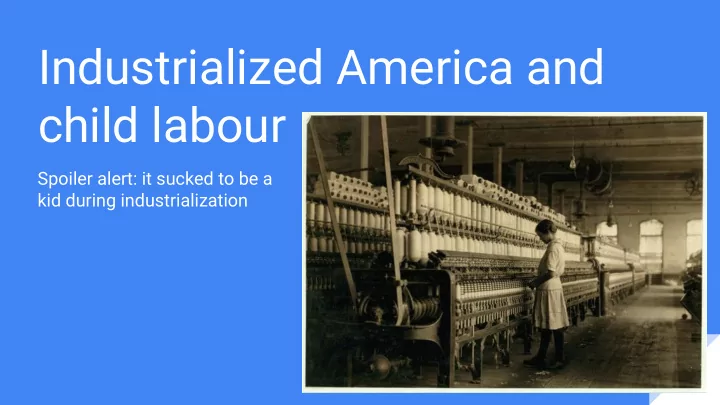

Industrialized America and child labour Spoiler alert: it sucked to be a kid during industrialization
Why are you at school today and not a factory? What is the origin of child labour laws?
Today’s Lesson Overview: Objectives: - Review the conditions of the period - Make you grateful to be in class today and - Examine the history of child labour not a factory - The long history of child labour - Understand the history of child labour in - Activity: group primary source analysis America - Look at how the government responded - Analyze photographs, using historical - child labour laws slowly spread methods - Discuss child labour today - Is it really gone?
Check your history: when did child labour “start”? - No definitive start date - Two forms: indentured servitude and domestic work - Indentured servitude = a contract where you sell your labour for a set time (ex. 2 years) - Domestic work = helping with framing, running of the family - Children were profitable : - Sellable (as slaves) - Extra hands (agriculture, domestic work) Young black “nanny”, Texas
Child Labour and Industrialization Industrialization increased child labour demand in America. Focus on increased production meant more child labourers . EX: 1890 the US Census estimated that roughly 1 million children were working . By some estimates, children ages 10-15 made up around 18% of the nation's total labor force
Why would children/family choose child labour?
- No access to education/people thought working was the best thing for childhood development - Small hands were good to get into machinery - You can pay them less - Families need all the money they can get - Less like to strike, unionize, stand up for their rights
Citizen action against child labour: National Child Labour Committee (NCLC) - Labour movements (mostly lead by women) campaigned fiercely, as early as 1832! - NCLC , f. 1904 - Mandate: to end child labour, provide free compulsory education - Lewis Hines joins the NCLC in 1909, starts photojournalism campaign
Lewis Hine, 1874 - 1940 Advertisement for the NCLC
Primary Source Analysis Time! As a class: Observe ● ○ What do you see? Reflect ● ○ Why do you think this photo was taken? ● Question What do you wonder ○ about?
ACTIVITY: Group Source ● Observe Analysis What do you see? ○ ● Reflect Why do you think this ○ - Groups of 3 max photo was taken? Question ● - Each group gets a random ○ What do you wonder historical photograph about? - 20 minutes discuss the following prompts (-->) - Be prepared to present your findings with the class
How did government respond? Started state by state : - 1836 : Massachusetts passes first child labor law - 1911-1914: Thirty-nine states pass child labor laws
Turning Point: Fair Labor Standards Act (1938) Fair Labor Standards Act (1938): - Set minimum working age at 14 (18 for hazardous work) - Set maximum hours for work: 18hr/week during the school year, 40hrs/week on vacation - Reasonable hours: 7AM - 7PM during school year, 7AM - 9PM otherwise
Question: is child labour gone today?
If you guessed yes, you’re wrong! It exists, but not in North America Factors that lead to the exportation of child labour: 1) Free trade 2) Globalization 3) IMF and World Bank
But how does it work exactly? National child labour laws often include exemptions, examples: Nepal: minimum age of 14 for most work. . . plantations and brick kilns are exempt. Kenya: prohibits children under 16 from industrial work. . . but excludes agriculture. Free trade allows the easy flow of these goods into Western markets
The problem also persists in North America!
What is our responsibility today? What did people of the past do?
Review and Recap Child labour: - Been around for a while - Got worse with industrialization People’s protest: - Started with labour and women’s movement - Slowly spread across states, until federal legislation Is it over though? - Not yet! Exists still, mostly in other parts of the world
Recommend
More recommend